Performance Analysis and Testing of Spiral Quantitative Fertiliser Distributors in Orchards
Abstract
1. Introduction
2. Materials and Methods
2.1. Overall Structure and Working Principle of the Fertilizer Distributor
2.2. Design of Critical Parts
2.2.1. Fertilizing Tank
2.2.2. Ditching Cutter Disc
2.2.3. Fertilizing Apparatus
- (1)
- Simulation verification test
- (2)
- Results analysis
2.3. Test Conditions and Methods
3. Results and Analysis
3.1. Regression Model Analysis
3.2. Response Surface Analysis and Optimization
3.3. Verification Test
4. Conclusions
Author Contributions
Funding
Institutional Review Board Statement
Informed Consent Statement
Data Availability Statement
Acknowledgments
Conflicts of Interest
References
- Li, H.; Zhan, L.; Jia, Z.; Peng, M.; Xin, X. Comprehensive assessment of fertilization, spatial variability of soil chemical properties, and relationships among nutrients, apple yield and orchard age: A case study in Luochuan County, China. Ecol. Indic. 2021, 122, 107285. [Google Scholar]
- St. John, J.L.; Overholser, E.L.; Overley, F.L. Effect of Orchard Fertilizer Applications on the Composition of Apples. Plant Physiol. 1942, 17, 435–446. [Google Scholar] [CrossRef]
- Kuzin, A.; Solovchenko, A. Essential Role of Potassium in Apple and Its Implications for Management of Orchard Fertilization. Plants 2021, 10, 2624. [Google Scholar] [CrossRef] [PubMed]
- Winklhofer, P.; Andert, S.; Hüttel, S.; Gerowitt, B. Measuring On-Farm Phosphorus Fertiliser Use-Lessons Learned from Surveying Data of Five Regions in Northern Germany. Agronomy 2021, 11, 2123. [Google Scholar] [CrossRef]
- Carbonell-Bojollo, R.M.; Veroz-González, Ó.; González-Sánchez, E.J.; Ordóñez-Fernández, R.; Moreno-García, M.; Repullo-Ruibérriz, M.A. Soil Management, Irrigation and Fertilisation Strategies for N2O Emissions Mitigation in Mediterranean Agricultural Systems. Agronomy 2022, 12, 1349. [Google Scholar] [CrossRef]
- Shi, Y.; Yu, H.; Jiang, Y.; Wang, X.; Chen, H.; Liu, H. Optimization of Strip Fertilization Planter for Straw Throwing and Paving. Agriculture 2022, 12, 613. [Google Scholar] [CrossRef]
- Landry, H.; Laguë, C.; Roberge, M. Discrete element modeling of machine–manure interactions. Comput. Electron. Agric. 2006, 52, 90–106. [Google Scholar] [CrossRef]
- Jie, H.; Jia, H.; Yang, W.; Yan, W.; Chang, C.; Zhen, R.; Xiao, L.; Shi, S.; Yi, D.; Pei, H. Design and study on lightweight organic fertilizer distributor. Comput. Electron. Agric. 2020, 169, 105149. [Google Scholar]
- Jiang, D.; Chen, X.; Yan, L.; Mo, Y.; Yang, S. Design and experiment on spiral impurity cleaning device for profile modeling residual plastic film collector. Trans. Chin. Soc. Agric. Mach. 2019, 50, 137–145. [Google Scholar]
- Du, J.; Yang, Q.; Xia, J.; Li, G. Discrete element modeling and verification of an outer groove wheel fertilizer applicator with helical teeth. Trans. ASABE 2020, 63, 659–664. [Google Scholar] [CrossRef]
- Gui, C.; Qing, W.; Di, X.; Hong, L.; Jin, H.; Lu, C. Design and experimental research on the counter roll differential speed solid organic fertilizer crusher based on DEM. Comput. Electron. Agric. 2023, 207, 107748. [Google Scholar]
- Kretz, D.; Callau-Monje, S.; Hitschler, M.; Hien, A.; Raedle, M.; Hesser, J. Discrete element method (DEM) simulation and validation of a screw feeder system. Powder Technol. 2015, 287, 131–138. [Google Scholar] [CrossRef]
- Yu, S. Optimization design of performance parameters of vertical screw conveyor. Mach. Des. Manuf. 2015, 11, 215–218. [Google Scholar]
- Xue, Z.; Zhao, L.; Wang, F.; Wang, S.; Wang, G.; Pan, R. Performance simulation test of the spiral fertilizer distributor based on discrete element method. Hunan Agric. Univ. 2019, 45, 548–553. [Google Scholar]
- Shu, Q.; Fang, G.; Dong, Z. The Study on Performance of Twin Screw Conveyer. Dry. Technol. 1996, 14, 7–8. [Google Scholar]
- Zhan, C.; Ding, W.; Han, Y.; Jiang, Q.; Zhao, Y.; Zhao, L.; Song, Z. Design and experiments of an automatic depth-adjusting double screw trencher and fertiliserning. PLoS ONE 2022, 17, e0277824. [Google Scholar] [CrossRef] [PubMed]
- Xiong, C.; Xi, L.; Zai, W.; Cheng, Z.; Ning, M.; Wen, J. Design and experiment of fertilizer distribution apparatus with double-level screws. Trans. Chin. Soc. Agric. Eng. 2015, 31, 10–16. [Google Scholar]
- Guo, D.; Wen, L.; Jia, D.; Cheng, Z.; Ning, M.; Wen, J. Optimal Design and Experiment of Arc-groove Double-spiral Fertilizer Discharge Device. Trans. Chin. Soc. Agric. Mach. 2022, 53, 118–125. [Google Scholar]
- Xu, X. Study on Fertilizer Distribution and Deep Application Apparatus with Double-Level Scews in Paddy Field. Master’s Thesis, South China Agricultural University, Guangzhou, China, 2019. [Google Scholar]
- Zhi, W.; Feng, L.; Xiao, W.; Jing, Z.; Xiang, S.; Hai, W. Design and Experiment on the Offset Fertilization Machine for Orchard. J. Agric. Mech. Res. 2023, 45, 115–119. [Google Scholar]
- Bu, H.; Yu, S.; Dong, W.; Zhang, L.; Xia, Y. Analysis of the Effect of Bivariate Fertilizer Discharger Control Sequence on Fertilizer Discharge Performance. Agriculture 2022, 12, 1927. [Google Scholar] [CrossRef]
- GB/T 20346.2-2022; Equipment for Distributing Fertilizer—Part 2: Fertilizer Distributor in Lines. Standardization Administration of China: Beijing, China, 2022.
- Wang, H.; Sun, X.; Li, H.; Fu, J.; Zeng, X.; Xu, Y.; Wang, Y.; Liu, H.; Lü, Z. Design and Parameter Optimization of a Finger Clip Plate Garlic Seed-Metering Device Based on EDEM. Agronomy 2022, 12, 1543. [Google Scholar] [CrossRef]
- Meng, Z.; Yu, T.; Hong, Z.; Hai, L.; Hao, N. Parameter Optimization of Spiral Fertilizer Applicator Based on Artificial Neural Network. Sustainability 2023, 15, 1744. [Google Scholar]
- Liu, L.; Li, Y.; Song, J.; Ma, T.; Wang, M.; Wang, X.; Zhang, C. Performance analysis and experiment on fertilizer spreader with centrifugal swing disk based on EDEM. Trans. Chin. Soc. Agric. Eng. 2017, 33, 32–39. [Google Scholar]
- Cai, Z. Application of Response Surface Method to Mechanical Structure Optimization. Master’s Thesis, Shanghai Ocean University, Shanghai, China, 2019. [Google Scholar]
- Yolmeh, M.; Jafari, S.M. Applications of Response Surface Methodology in the Food Industry Processes. Food Bioprocess Technol. 2017, 10, 413–433. [Google Scholar] [CrossRef]
- GB/T 20001.4-2015; Rules for Drafting Standards—Part 4: Test Method Standards. Standardization Administration of China: Beijing, China, 2015.
- NY/T 1003-2006; Technical Specification of Quality Evaluation for Fertilizing Machinery. Ministry of Agriculture of the People’s Republic of China: Beijing, China, 2006.

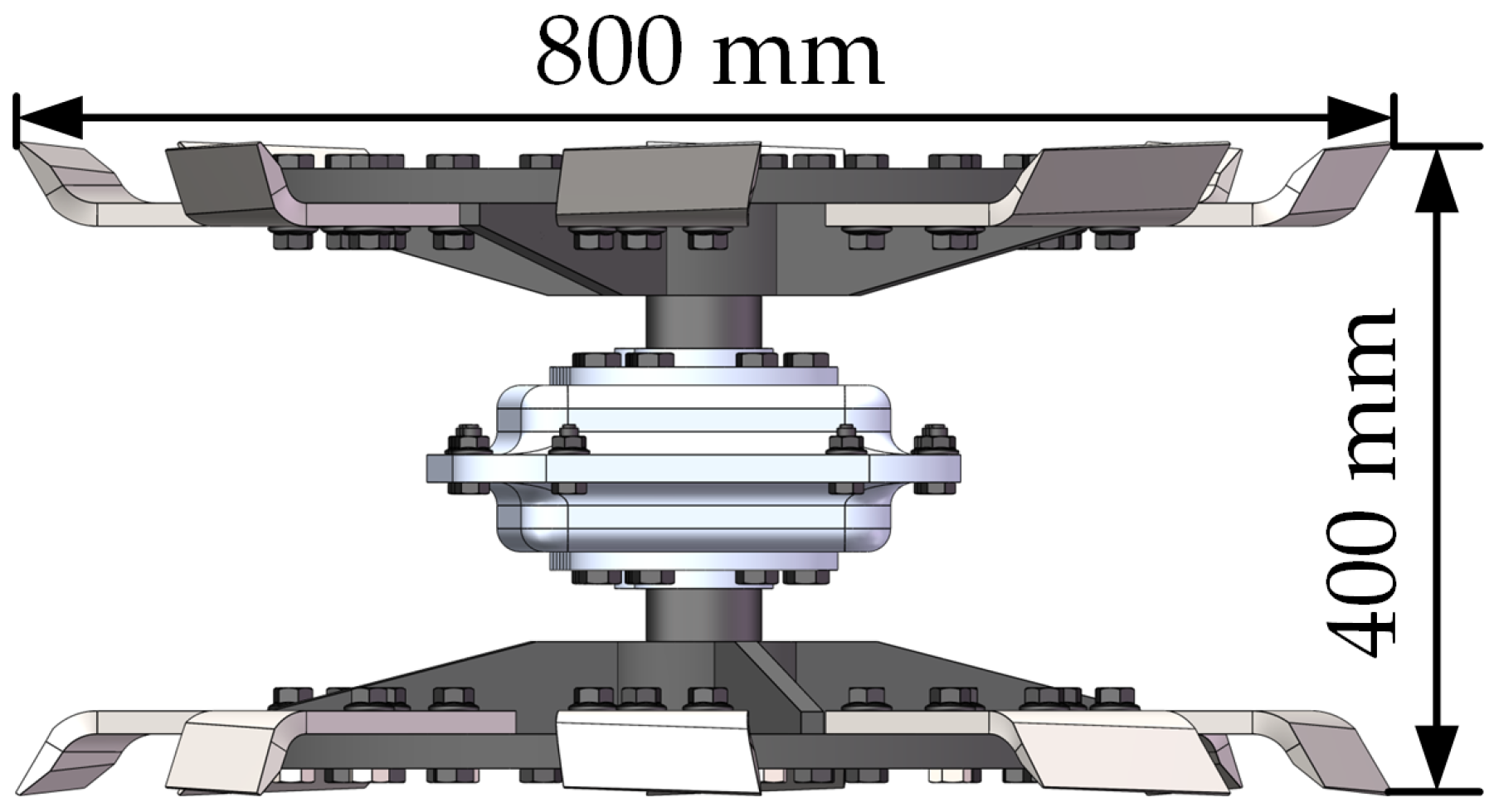
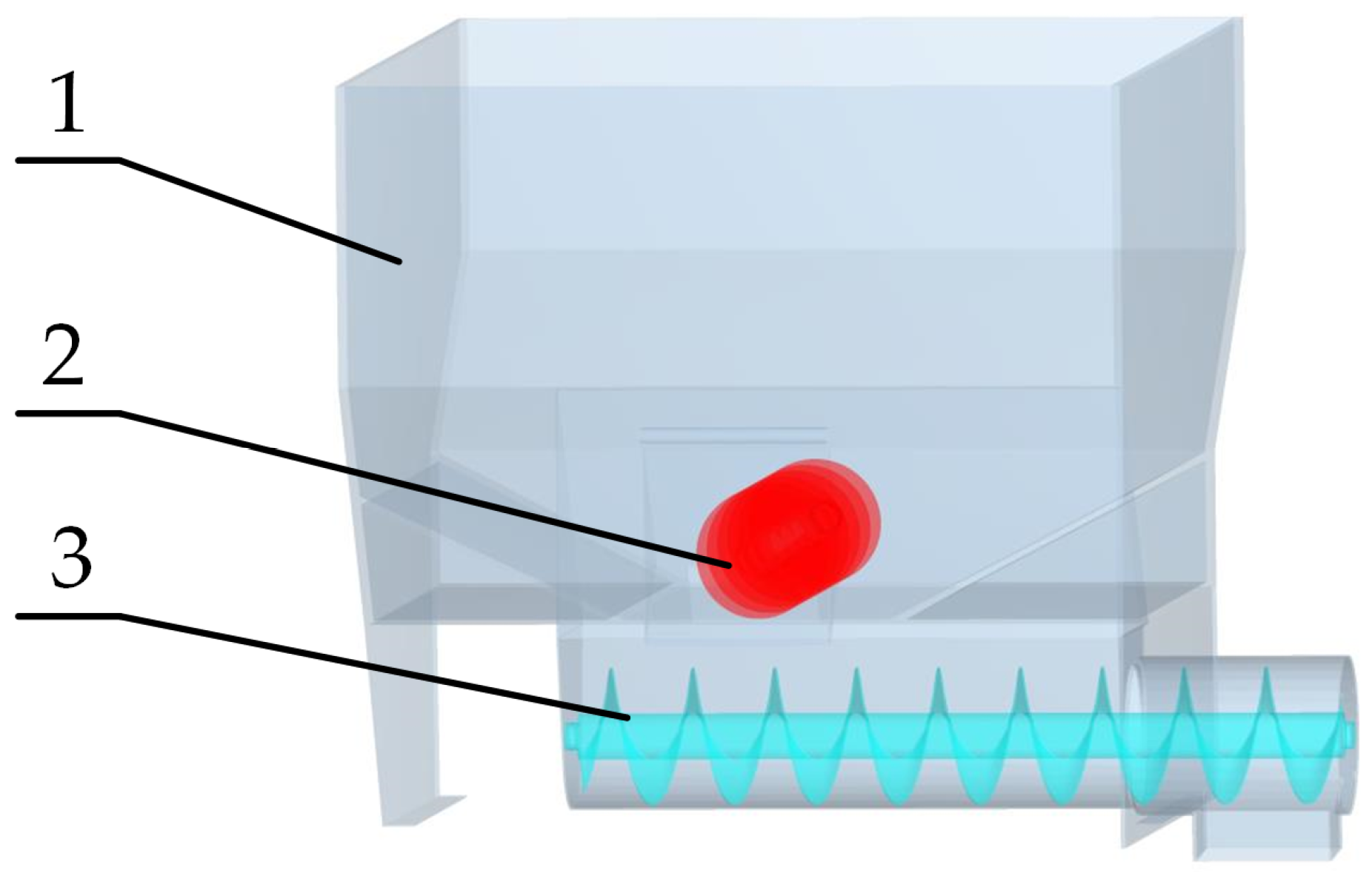
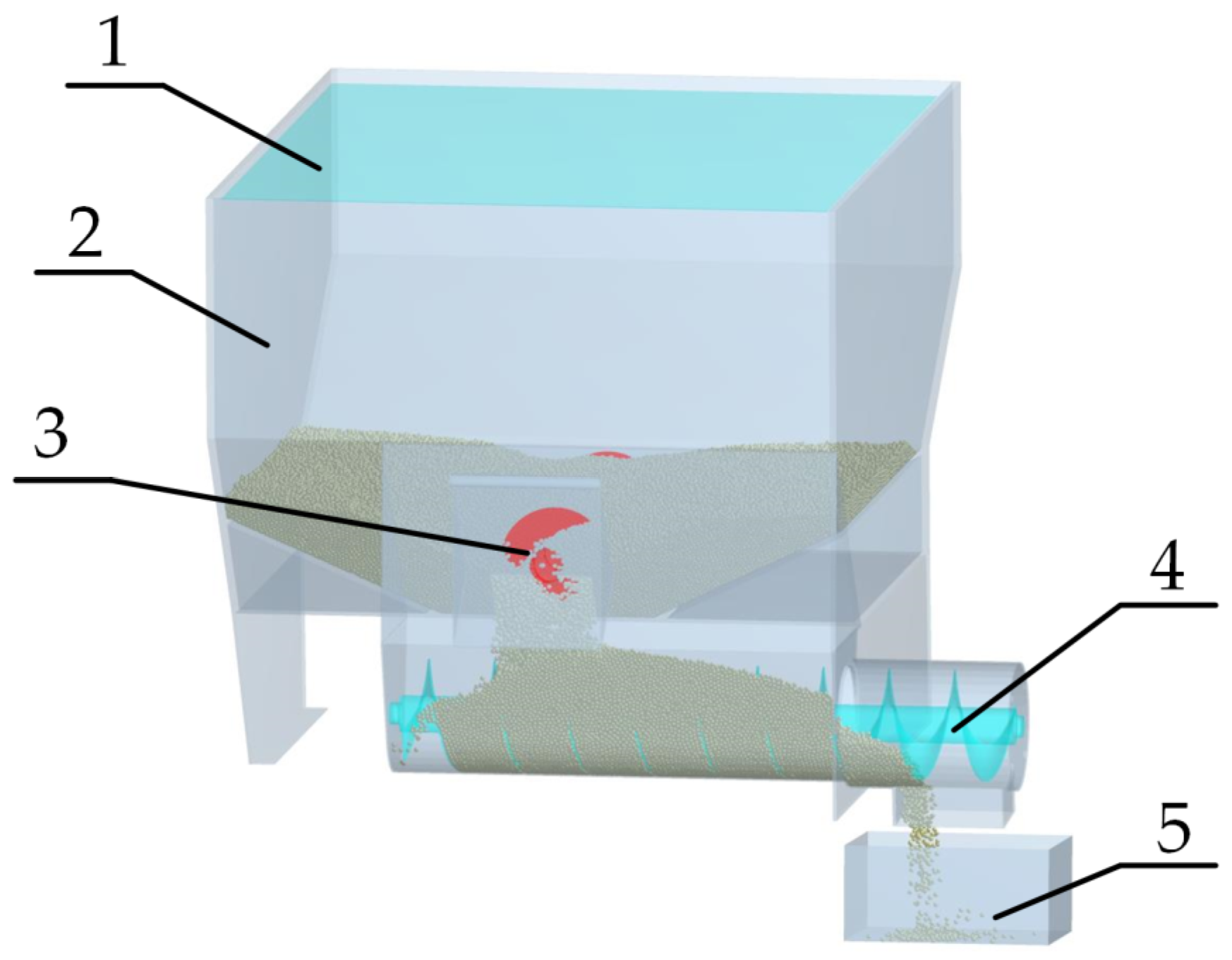
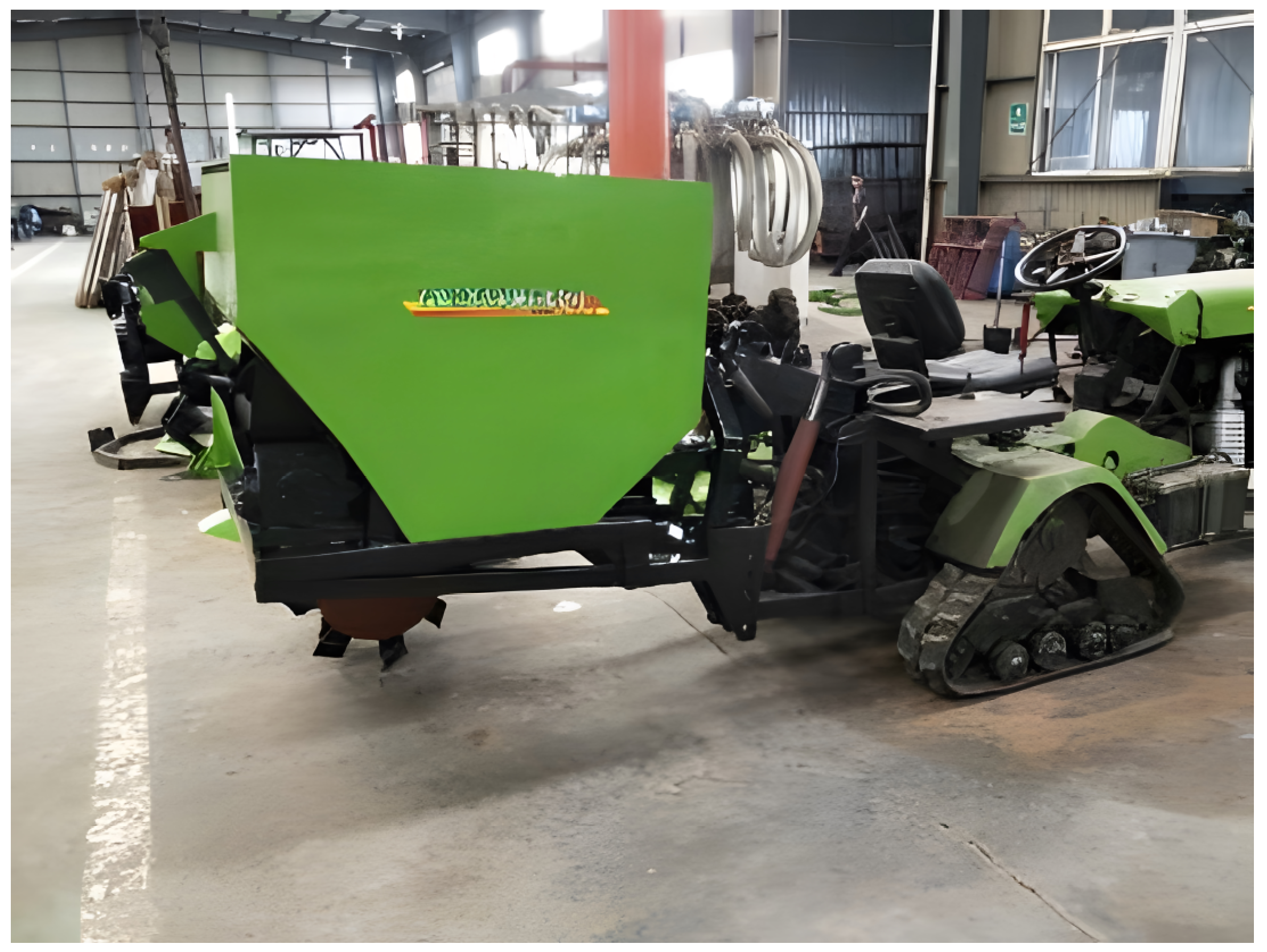
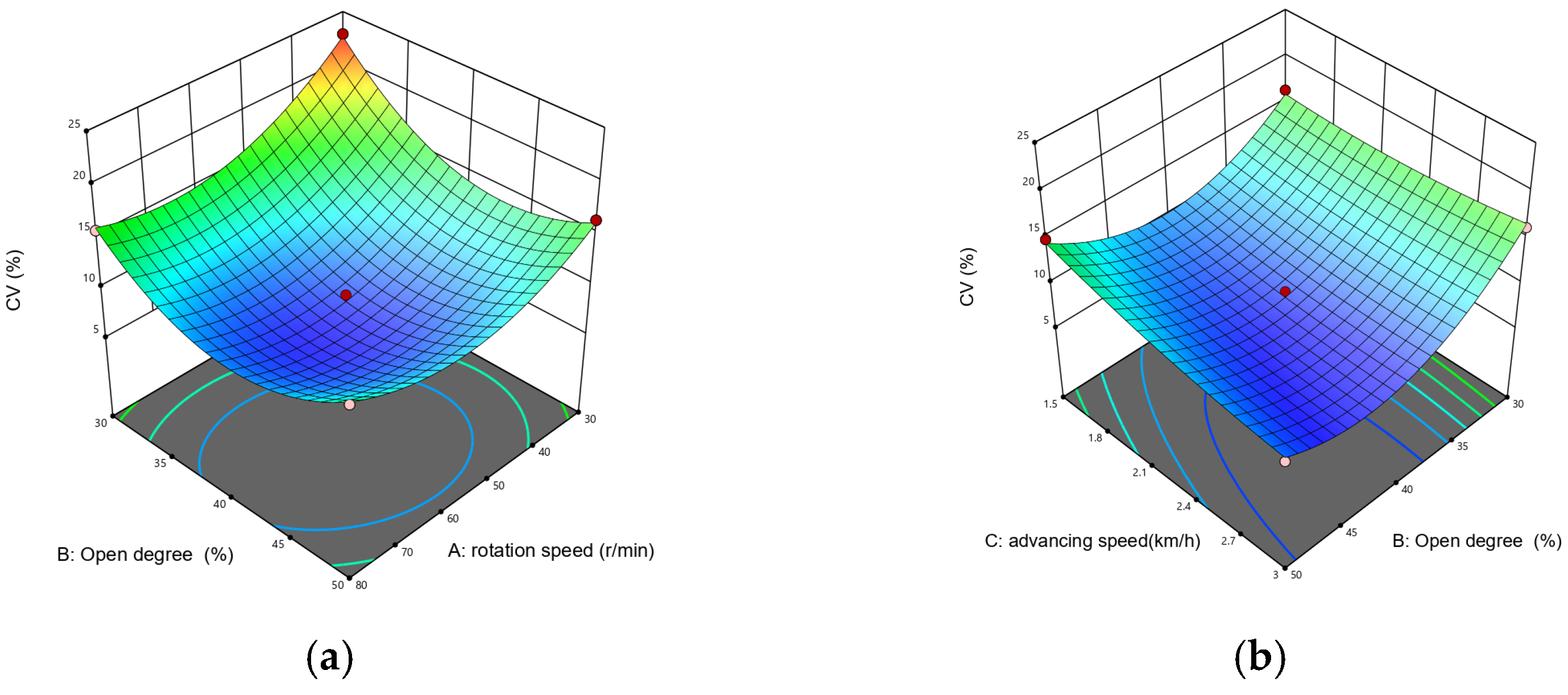
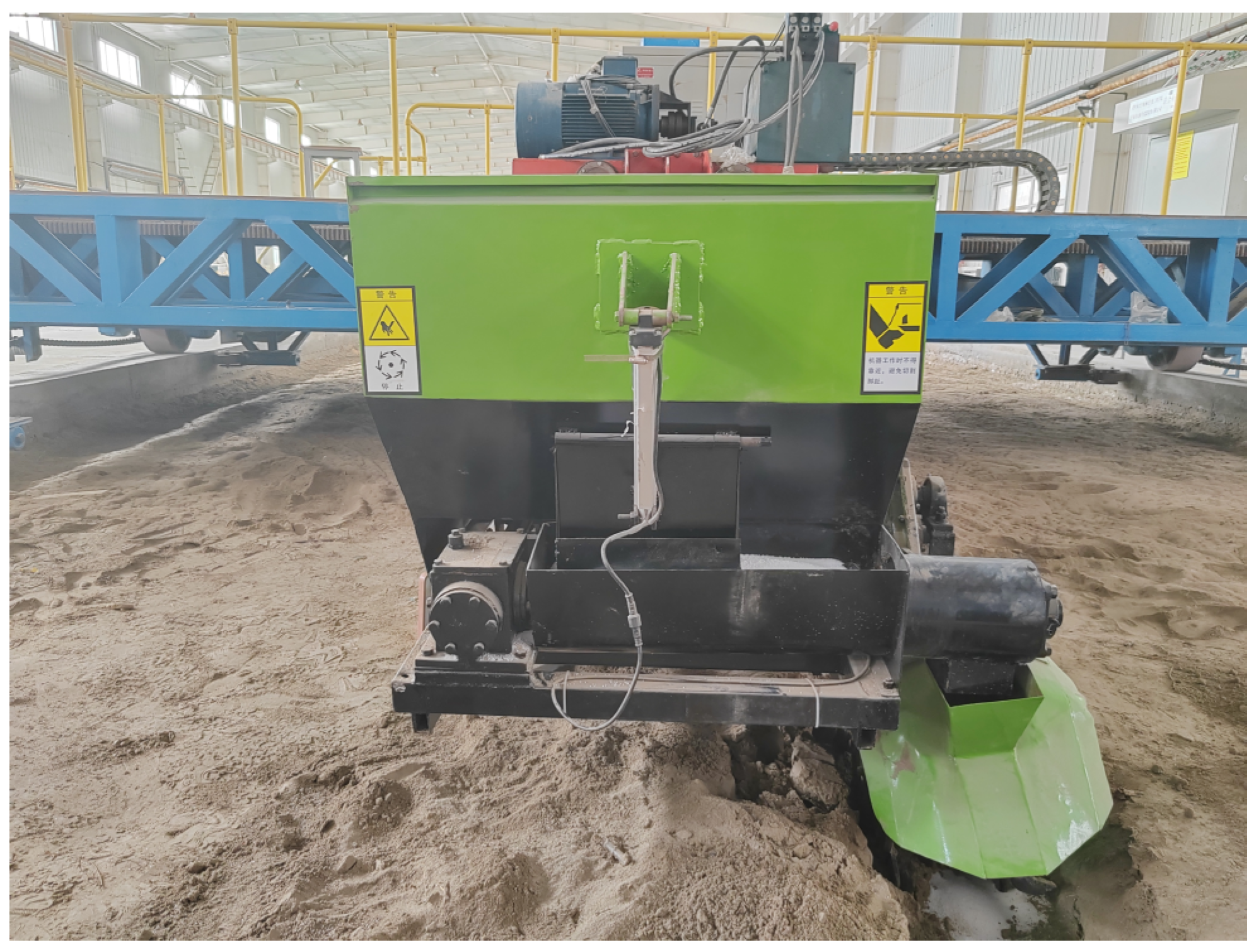
| Attribute | Value |
|---|---|
| Particle diameter (mm) | 3.6 |
| Particle density (kg/m3) | 1320 |
| Particle Poisson ratio | 0.25 |
| Particle shear modulus | 2.8 × 107 |
| Restitution coefficient | 0.11 |
| Particle static friction coefficient | 0.3 |
| Particle kinetic friction coefficient | 0.1 |
| Coefficient of static friction between the particle and the mechanism | 0.26 |
| Coefficient of dynamic friction between the particle and the mechanism | 0.18 |
| Restitution coefficient between the particle and the mechanism | 0.41 |
| Mechanism Density (Steel kg/m3) | 7800 |
| Mechanical Poisson ratio | 0.3 |
| Mechanical shear modulus (Pa) | 7 × 1010 |
| Level | Factor | ||
|---|---|---|---|
| Spiral Rotation Speed A (RPM) | Opening Degree of Fertilizer Outlet B (%) | Advancing Speed C (km/h) | |
| −1 | 30 | 30 | 1.5 |
| 0 | 55 | 40 | 2.25 |
| 1 | 80 | 50 | 3 |
| Test Number | A (RPM) | B (%) | C (km/h) | CV (%) |
|---|---|---|---|---|
| 1 | 30 | 30 | 2.25 | 22.82 |
| 2 | 80 | 30 | 2.25 | 15.69 |
| 3 | 30 | 50 | 2.25 | 16.34 |
| 4 | 80 | 50 | 2.25 | 13.74 |
| 5 | 30 | 40 | 1.5 | 15.35 |
| 6 | 80 | 40 | 1.5 | 11.69 |
| 7 | 30 | 40 | 3 | 14.28 |
| 8 | 80 | 40 | 3 | 10.23 |
| 9 | 55 | 30 | 1.5 | 16.32 |
| 10 | 55 | 50 | 1.5 | 14.89 |
| 11 | 55 | 30 | 3 | 16.21 |
| 12 | 55 | 50 | 3 | 9.06 |
| 13 | 55 | 40 | 2.25 | 8.05 |
| 14 | 55 | 40 | 2.25 | 8.46 |
| 15 | 55 | 40 | 2.25 | 8.34 |
| 16 | 55 | 40 | 2.25 | 8.26 |
| 17 | 55 | 40 | 2.25 | 9.12 |
| Source | Sum of Squares | DF | Mean Square | F-Value | p-Value |
|---|---|---|---|---|---|
| Model | 273.80 | 9 | 30.42 | 81.17 | <0.0001 |
| A | 38.02 | 1 | 38.02 | 101.44 | <0.0001 |
| B | 36.17 | 1 | 36.17 | 96.50 | <0.0001 |
| C | 8.97 | 1 | 8.97 | 23.93 | 0.0018 |
| AB | 5.13 | 1 | 5.13 | 13.69 | 0.0077 |
| AC | 0.0380 | 1 | 0.0380 | 0.1015 | 0.7594 |
| BC | 8.18 | 1 | 8.18 | 21.82 | 0.0023 |
| A2 | 58.72 | 1 | 58.72 | 156.68 | <0.0001 |
| B2 | 103.88 | 1 | 103.88 | 277.17 | <0.0001 |
| C2 | 2.10 | 1 | 2.10 | 5.62 | 0.0496 |
| Residual | 2.62 | 7 | 0.3748 | ||
| Cor Total | 276.42 | 16 |
Disclaimer/Publisher’s Note: The statements, opinions and data contained in all publications are solely those of the individual author(s) and contributor(s) and not of MDPI and/or the editor(s). MDPI and/or the editor(s) disclaim responsibility for any injury to people or property resulting from any ideas, methods, instructions or products referred to in the content. |
© 2023 by the authors. Licensee MDPI, Basel, Switzerland. This article is an open access article distributed under the terms and conditions of the Creative Commons Attribution (CC BY) license (https://creativecommons.org/licenses/by/4.0/).
Share and Cite
Wang, X.; Tang, Y.; Lan, H.; Liu, Y.; Zeng, Y.; Tang, Z.; He, Y.; Zhang, Y. Performance Analysis and Testing of Spiral Quantitative Fertiliser Distributors in Orchards. Appl. Sci. 2023, 13, 8941. https://doi.org/10.3390/app13158941
Wang X, Tang Y, Lan H, Liu Y, Zeng Y, Tang Z, He Y, Zhang Y. Performance Analysis and Testing of Spiral Quantitative Fertiliser Distributors in Orchards. Applied Sciences. 2023; 13(15):8941. https://doi.org/10.3390/app13158941
Chicago/Turabian StyleWang, Xingyu, Yurong Tang, Haipeng Lan, Yang Liu, Yong Zeng, Zhihui Tang, Yichuan He, and Yongcheng Zhang. 2023. "Performance Analysis and Testing of Spiral Quantitative Fertiliser Distributors in Orchards" Applied Sciences 13, no. 15: 8941. https://doi.org/10.3390/app13158941
APA StyleWang, X., Tang, Y., Lan, H., Liu, Y., Zeng, Y., Tang, Z., He, Y., & Zhang, Y. (2023). Performance Analysis and Testing of Spiral Quantitative Fertiliser Distributors in Orchards. Applied Sciences, 13(15), 8941. https://doi.org/10.3390/app13158941







